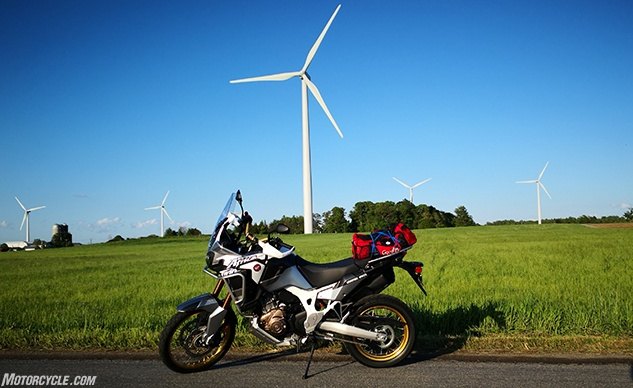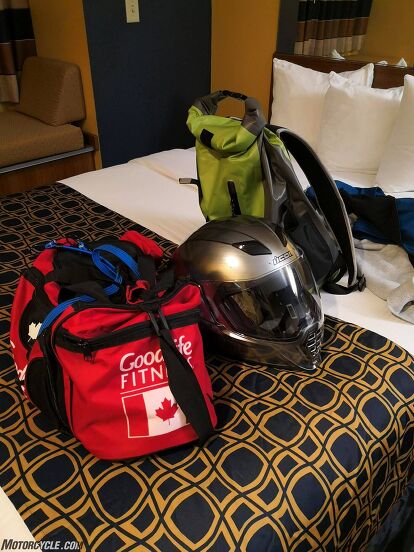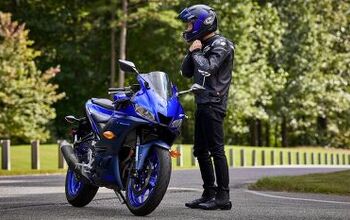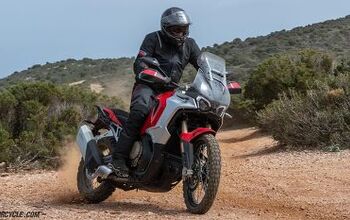Me, The Africa Twin, 1,000 Miles, And 3 Days
A rookie's first solo distance ride (and mistakes to avoid)
Trips like this always sound like such a great idea… You have somewhere you need to be in a certain time frame, and the weather looks clear. There are important personal matters requiring resolution on a Monday morning, and with my initial plan to fly now gone askew, I was staring into the driveway at the Africa Twin and pondering. How hard could it be, right?
All told, I still call myself a rookie rider. I spent some time riding dirt bikes as a teen and spent a couple of years licensed and riding in Vancouver, though that chapter came to a close in 2005. Riding again extensively for a touch over a year now (with some professional instruction along the way to dust off those old skills), I’m on the road a lot, though miles from ever calling myself a seasoned/veteran rider. Prior to this potentially overzealous undertaking, I’d never logged more than a couple continuous riding hours in a day.
The DCT-equipped Africa Twin Adventure Sports had been in my driveway for a week or so already as part of a 3-week loan from Honda Canada – long enough for me to know that I was quite comfortable on the big adventure bike – and my thought process was equal parts logical and over-simplified. There was an internal need/want/desire to get my first distance ride under my belt, and being a short trip (leaving Toronto on Sunday, and making it back by end-of-day Tuesday) I wouldn’t have to stress about packing too much onto the bike; stock luggage was not available to be equipped.
I’m not here to wax poetic about my cruise through upstate New York and Pennsylvania, as much as I’m not here to provide anyone with a road trip guide, or any formal kind of “do’s and don’ts” for long haul riding. One single trip does not an expert make. More than anything, I’m writing this for others like me – the other newbies out there that might not have a circle of veterans around them or maybe those of us who are a bit too cocky to ask others for insight.
Loading Up
Though the Africa Twin wasn’t set up with luggage, I did have a tail rack, which ended up making life relatively easy when setting up for the ride. I knew there was a mild risk of hitting some rain. So, with limited time and resources available, I set out to pack accordingly. On the tail of the bike would be a simple duffel bag, with its contents securely double-bagged to avoid a potential soaking. Given that no at-home “make it waterproof” solution is foolproof, this was reserved for clothes, spare gear, and toiletries.
I knew at least one piece of properly waterproof luggage would be essential, as my camera (as well as copies of paperwork I was heading south to deal with) needed to stay dry. Considering this wouldn’t be a ton of excess weight, I went the route of a roll-top dry bag with well-padded shoulder straps (and chest strap). Since it was originally intended for camping and canoe trips, I knew I could trust that the essentials would stay dry. The low volume of straps/clips/etc would help avoid having any nonsense flapping away in the wind.
The Smart Gear:
Nelson Rigg Dual Sport Saddlebags: $126
SeaLine Big Fork Dry Pack: $130
HDX 6-pack Flat Bungee Cords: $6
Departure/Initial Stint
New bike, new adventures, right? My first mistake (which I would only discover a little later on) was really a matter of timing. These grand ambitions of mine to get out the door by midday on Sunday were quashed by trying to tie up a few loose ends before my departure. I’d mapped my route repeatedly, and on paper, I was looking at just under 500 miles. Adding in an hour or so for pit stops (in my obliviously optimistic mind), that would put me into Manhattan from Toronto by between 9 or 10 pm if I left midday. By foolishly pushing my start time back to 3:25pm, I still had this faint hope that I would be able to muscle on and into the city in a single day.
With temperatures floating in the mid-60s, staying comfortable temperature-wise was a non-issue on the Africa Twin, though I became aware of a couple of concerns that were destined to plague the balance of my ride. First of all, my other brief highway stints on the Africa Twin hadn’t revealed the obnoxious wind buffeting I experienced as I made my way down to (and across) the US border. With my 6’1” frame, my helmet basically landed right at the cut-off of windscreen protection, and at anything over about 65 miles per hour, I effectively became an involuntary high-speed bobble-head. Most of my riding to date has been on bikes with little in the way of wind protection, and frankly, I’d rather endure having my body act as a parachute than this droning discomfort. Based on some of the forum feedback I’ve seen since the ride, the jury is still out on what the perfect fix is, though a number of different aftermarket windscreens have been said to improve things a touch.
This wind buffeting also laid the groundwork for what was to become a bigger problem for surviving this adventure. I’ve been running the ICON Airflite Quicksilver helmet since my January ride sessions with the Ducati Scrambler, and other than being a tiny bit light on venting, it had given me little to complain about (plus its drop-down sun visor works great when frequently transitioning between sunlight and shade). However, after my first three or four hours on the road, pressure points at the corners of my forehead were causing a headache to set in. Pulling off the road and simply having the lid off my head for 10 or 15 minutes, quickly acted as a reset, leaving me surprisingly refreshed and ready to get back at it, but I still stocked up on Advil to try and help keep this at bay.
The Smart Gear:
Aftermarket Windscreen: Prices Vary
Icon Airflite Quicksilver Helmet: $290
Darkness And Weather
Realistically speaking, the first six or so hours of riding progressed relatively smoothly. No signs of inclement weather had yet to appear, and I blasted through a beautiful forgotten stretch of road (highway 20A, connecting East Aurora to Mount Morris, and allowing for a bypass of Rochester). Other than my helmet complaint, it was basically smooth sailing.
And then it got dark.
Shortly after 9 pm when proper darkness had fallen on the roads, temperatures began to plummet into the 40s, and I was in dire need of a gear swap. Though I was riding light on gear overall, I did pack a solid volume of additional layers. From the waist down I was well equipped – Uniqlo HeatTech thermals, two layers of thick socks, jeans, and (once again) Icon riding pants. The PU-coated denim Icon 1000 Varial pants were proving super effective at blocking out the wind, and with the second set of socks the thick lining of my Truant 2 boots ( reviewed here) were keeping my toes warm enough.
When it comes to upper body warmth, my plan was at least a little flawed. With only two jackets in my roster, and one being more geared towards urban riding, I wound up in a relatively light textile jacket, with the idea of packing several layers to pile on underneath as needed. On one hand, this made it easy to adjust levels of warmth during daytime riding and avoid any potential overheating. Now, in the darkness and with a chill setting in, staying warm was proving to be a bit of a challenge. My first serious layer-up after 9 pm made a reasonable difference. However because there was no solid shield between the wind and the layers of cotton and polyester beneath, it was only a matter of time before that outside air made mockery of my attempt at insulation. Veteran riders will always say that good gear makes all the difference – they’re right. Though I was at least on the right track with the mindset of “pack for the weather you might hit, not the weather in your driveway,” spending coin on a proper adventure/touring jacket (like the Alpinestars Andes Pro Drystar, for example) would have made a massive difference.
The Smart Gear:
Icon 1000 Varial Pant: $175
Alpinestars Andes Pro Drystar Jacket: $550
Tapping Out
I hate failure. Being the type to weigh things out, calculate, plan, and organize, I think I set reasonable targets for myself, and when those targets can’t be achieved, I’ll often hold on as long as I can before abandoning hope. That said, I also really value staying alive. I knew relatively early on that I was off track from a timing standpoint, but it was now 11:30 pm and I was in Binghamton, New York, leaving more than 3 hours to go before NYC. Having maintained a reasonable rotation of food and caffeine throughout the ride, I was only slightly starting to feel an onset of fatigue, but I had a bigger concern in front of me. Fog had set in heavily just outside Binghamton, visibility was trash, and I had donned my last upper body layer.
You can plan, estimate, and project an outcome all day long, but unlike an automotive adventure, you’re really at the mercy of the road, mother nature, and your own physical limitations. Had I left earlier, maybe I would have made it all the way. However, that also would have put me through a rainstorm, opening up another world of variables that I was also ill-equipped to manage. Into Scranton by 1 am and asleep by 1:20, I found that a quick 5-hour rest was enough to recharge. Warm sunlight ensured a comfortable final cruise into New York was about as painless as one could expect after the previous day.
Rinse and Repeat – The Battle Of Monotony and Fatigue Management
Having so much time “alone” so to speak, cut off from communication with the outside world other than through lights, signals, and hand gestures – it gets to you after a while. Still green, I’m still very much in that “no distractions” mindset, which means no GPS, no outside audio, etc. That’s all well and good in the city or when out for a few hours at a time, but it’s hard to not get in your own head when you’ve been on the road for so many hours with nothing but the sound of your own thoughts rattling around. On the plus side, there’s an almost meditative clarity that comes from being able to think through things when nothing other than traffic can distract you. Let me put it this way, I can certainly appreciate the value/benefit of Bluetooth headsets now, and one will certainly be on my radar before the next long haul. One massive moto meditation is enough for a season, as far as I’m concerned.
The Smart Gear:
The Final Leg
They say that accidents always happen within the first and last few miles of any commute, and though (knock on wood) nothing went awry in that respect during my final miles, they were certainly some of the toughest. My last gas stop in East Aurora I was anticipating being my final stop other than the border, but as soon as I crossed into Canada, it’s almost as if my body sensed proximity to home and just stopped hiding its fatigue from my mind. Everything started hurting, the temperature spiked, and I started sweating bullets. Then came the wind. Between Buffalo and Toronto, there is a long stretch of highway that’s open to Lake Ontario, and I was being pummelled to the point that I occasionally used semi trailers as a blast shield. I can make it, I can make it, come on, it’s right f%$#@ there.
Another stop. Less than 45 minutes from home. I get there when I get there. I had done my best to remember this mantra throughout the return home, and I had to force another reminder, sitting on the curb by a gas station. It was a long ride, it was over 1,000 miles in 52 hours, and though it was anything but perfect, I made it and (with the right equipment) would do it again.
We are committed to finding, researching, and recommending the best products. We earn commissions from purchases you make using the retail links in our product reviews. Learn more about how this works.
More by Justin Mastine-Frost
















































Comments
Join the conversation
Reliable sources are reporting a significantly revised AT for 2020, with a displacement bump and the larger fuel capacity across the board. HP and torque are up slightly, but it sounds like Euro 5 compliance was a primary objective. Of course, the real question is whether Big Red will finally listen to all of the banging--at least from me--and fit factory cruise control to this fully-compatible, throttle-by-wire, comfy, long-distance machine. I would respectfully suggest that this application is guaranteed visible to a blind man on a dark night from 30,000 feet--except, apparently, to Honda. Well, and to Suzuki. Suzuki should pay attention, too. The two machines screaming for cruise control the loudest at the moment are the AT and the VStrom.
Others have already described how rain gear can also protect you from the cold. If don't have rain gear, and if you don't have any more layers to put on, find yourself some newspaper. Layer that beneath your riding jacket. It helps!
No, no, no. If your own thoughts aren't good enough for you, forget motorcycles and stick to smartphones.